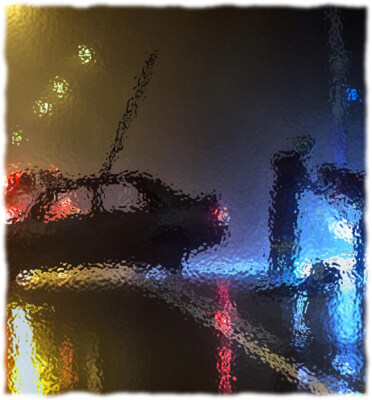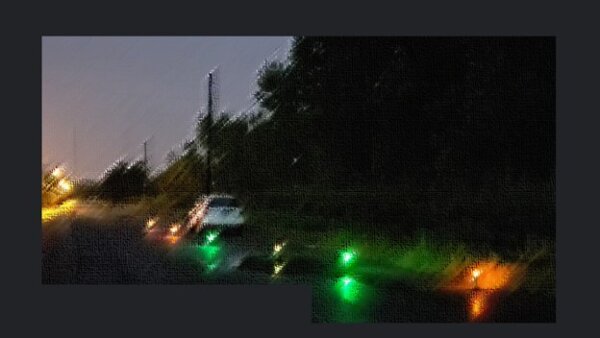
“Wha’ ?????!!!“
So what brought me to THIS topic? Let me tell you!
Over the past few days we’ve had HEAVY rains here in SoCal, thanks in part to another “Atmospheric River” roaring in off the Pacific. We get a couple dozen of these “rivers” every year. In just hours they can create monster surf and dump massive amounts of rain, resulting in flash flooding and land slides. Visibility is reduced. Driving conditions deteriorate quickly. Accidents happen – maybe like the one shown in the image above. So this article about emergency flares is first for my west coast neighbors, and then for anyone who ends up driving in the rain – which should probably be everyone!
Imagine suddenly coming across this situation in the pouring rain or fog. Can you tell what’s happening? What’s that pole or wire over the car? Are those emergency workers off to the right? With just a single flare on the ground close behind the car, is it clear what you should do? Stop entirely? Go left or right to get out of the way of someone coming up behind you?
I am convinced that having good emergency flares, the right number of them and knowing how to set them out could make a huge and life-saving difference. In the past I’ve written about flares and reflective triangles. This is an update because climate – and technological solutions – have changed!
My first update question has to do with technology. What makes a good emergency flare today?
Our CERT training story . . .
About 15 years ago our local CERT program offered an update training for graduates: “How to use road flares.” Of course, we signed up! On the designated date we joined about 20 other grads at 8 pm in a parking lot behind the local police station. Weather was sparkly clear but very cold. Most of us had never touched a flare in our lives.

A half dozen flares were handed out. They were the traditional waxed (strike) flare with a plastic cap, over a foot long and surprisingly heavy. (Probably 20- or 30-minute burn time but I didn’t know the difference.)
An officer demonstrated how to light the flare.
Not one of the CERT grads could get their flare to light.
Multiple tries later, some did. A few just gave up entirely and handed the flares over to the next person.
We got some valuable experience, and some good advice.
After all these years, I recall these safety pointers:
- When you light the flare, it may spit sparks! Hold the flare pointed down and away from your body.
- Plan where to put the flare so other drivers will see it. That may be 100 to 200 feet behind your car, depending on the speed of the traffic.
- Don’t toss the flare! Place the flare where it won’t roll and catch something else on fire – like grass beside the road or gas spilled on the road.
- When the situation is cleared up, extinguish the flare by grinding it out on the ground. You can also just let it burn itself out.
By the end of the session, it was clear: If you intend to use wax flares, you’d better burn up a few in practice before you have to light one up for real!!
Me being me, I also came up with this conclusion: A wax flare is a HOT CHEMICAL FIRE just waiting to jump out and get me!
In an emergency, when I’m scared and nervous, I’d want something easier and safer to handle! So what’s an alternative to the wax flare?
Today’s simpler and safer alternative is the LED flare!
By 2019, LED lighting had become the lighting standard. Today, LED flares compete successfully with wax flares. With cool lights driven by batteries (some rechargeable), the LED flares can run for hours if need be. Some are even water-resistant. When the event is over, these flares can be packed up for use another day! (May take fresh battery power, of course.)
The most popular LED emergency flares today are nicknamed “hockey pucks.”

It’s easy to understand the name. The flare is a disk about 4 in. across and a little more than an inch thick. According to ads that show them being driven over by big truck tires, they are practically crush proof! (Of course, if trucks or cars are actually running over your flares, that probably means they aren’t seeing them!)
Hockey pucks come in packs. some with carrying cases and other safety tools. Most pucks have an orange shell of aluminum or plastic, perhaps with a magnet or handle. As for the lights inside, on some models of pucks, pressing a switch may change flash patterns (solid, blinking, rotating) and colors (white/red).
With all these options, prices range widely – starting as low as $20 and going up to over $100 for multi-pack kits. Interested in checking out some actual products? Click here to go directly to a popular flare kit at Amazon where, as you know, we are Affiliates and receive a small commission if you buy through one of our links.
I really like the idea of these simple, easy on, easy off reusable tools!
But wait!
As we view image after image of rain damage and flooding here in California, it’s clear to me the hockey puck’s light would disappear completely under heavy rain, on a flooded street, or in falling snow – just when you need it most! So . . .!
Is there a third option? Let’s take a look at another, more robust version of an LED flare.
I first noticed this flare in a photo on LinkedIn. Here’s a version of that photo, slightly edited.

When I compare this accident setting to the one at the top of this page . . .
- First, I see multiple flares, not just one or two.
- The first flares are far enough away from the disabled car that if I were approaching it, I’d have time to slow down.
- Flares are set to direct vehicles around the disabled car. (This photo is actually from a video, which shows the lights blinking in a rotating flash pattern.)
- The green and orange colors pop!
As a driver coming across this scene, I would know just what to do — namely, slow down and ease left around the disabled car!
The image struck me so powerfully that I clicked through to the manufacturer’s website.

I discovered that this stand-up LED flare is called the BEACON-4-LIFE from Life Safety Lighting. After looking at photos and videos and reading all the FAQ at the site, I was even more intrigued. So, I picked up the phone to talk to the owner and inventor, Danny Vartan.
After 17 years’ service as a firefighter, Danny knows the dangers associated with combustible flares. And he’s watched as people have abandoned wax flares for plastic hockey puck flares. He isn’t entirely satisfied with either option – and generously responded to all my questions about why not. Some of my questions are below . . .
- “Are wax flares truly dangerous?” Do people get burned? Have wildfires been started by flares? Have people been killed at accident sites because flares weren’t visible? Danny’s answer to all these questions is, ”Yes.” And while flare-related “accidents” don’t seem to be tracked . . . this is clearly a concern.
- “Does a wax road flare expire?” (I’m thinking of all the people I know who carry stuff in their cars for years!) Interestingly enough, there’s no expiry date for auto flares, unlike military and coast guard flares. In any case, if your flare is cracked or punctured, has gotten wet, or been stored at high temperatures for an extended period – you could be dealing with a much more vigorously burning flare when you try to light it. Replace old flares!
- “How many flares does it take to safely protect a disabled car and its occupants – or, for that matter, First Responders on the scene?” Three is the minimum (one on top, one in front, one behind). According to Danny, the optimal number is five. (That’s also what his police customers buy most frequently.) You may need even more if cars are approaching from around a corner.
- “How does the BEACON-4-LIFE differ from other LED flares?” First, it stands tall – about 12 inches high. It’s heavy enough to be very stable, thanks to its batteries and a rubber base (or optional magnetic base). A smaller version of the light, called EMERGI-SAFE, is about half as high. Both versions have 20 high intensity LEDs that provide a full 360° of visibility and can be converted for use as a flashlight. For professional use, the BEACON-4-LIFE and EMERGI-SAFE have a clip that allows the flare to attach to a standard cone, doubling their height. These flares can actually be tucked INSIDE a rubber cone at night, turning the whole cone into a glowing orange light.
- “How are the lights powered?” Alkaline batteries power the lights, NOT rechargeable batteries. I was pleased to hear that, because here at Emergency Plan Guide we caution against counting on being able to recharge your devices in an emergency.
- “What’s the story with the colors?” The flares display either one or two colors (combinations of red, blue, amber, green, and white). The two-color modules can be set to flash in six different modes – like triple strobe, fast flash, etc. According to Danny, the amber and green light combination shown in the image has become particularly popular because it stands out so clearly from brake lights or turn signal lights.
As you would expect, at around $60 each these flares are more costly than wax flares or hockey pucks. Since they have a long, reusable life, however, their only ongoing cost is for replaceable batteries. One of these flares can replace hundreds of combustible flares.
You can see that I am enthusiastic about enhanced LED emergency lights. If you too are concerned with road safety, I encourage you to spend some time at Danny Vartan’s website, Life Safety Lighting. And if you have questions that aren’t answered there, call him up just like I did. (His phone number is on the “Contact” page of the site.)
Stay safe out there,
Virginia
Your Emergency Plan Guide team
Disclaimer: At Emergency Plan Guide we are not professional First Responders, or, for that matter, people who regularly work in dangerous outdoor settings. Firefighters or police will want to know a lot more about flares than what is in this Advisory.
P.S. For everyone: When you consider the value of the vehicle you are driving (in the 10s of thousands of dollars?), and the risk of injury or even death in an accident – going for the cheapest item on the shelf doesn’t make sense.
In the late 90s, a nephew of ours found himself on a rural road at 2 a.m. with a broken-down car and no lights of any kind. He never made it home; he was hit and killed by a passing car. Even one emergency flare might have saved his life.
Don't miss a single Advisory.
Thank you for subscribing.
Something went wrong.
